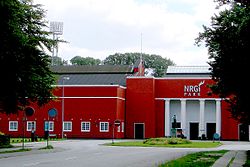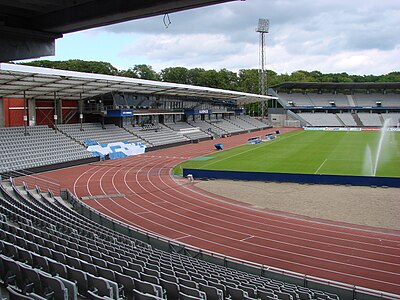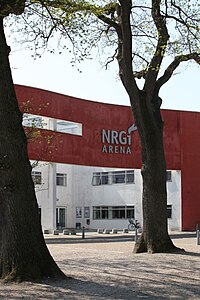Aarhus Stadium
Aarhus Stadium | |
 Naming rights agreement since July 2015 | |
 View from the outside | |
 | |
| Former names | Aarhus Stadium (1920–present) Atletion (2003–2006) NRGi Park (2006–2015) Ceres Park (2015–present) |
|---|---|
| Location | Stadion Allé 70 DK-8000 Aarhus C |
| Coordinates | 56°07′55″N 10°11′48″E / 56.132033°N 10.196589°E |
| Owner | Ceres Park & Arena (AGF)[4] |
| Capacity | 19,433 |
| Surface | Mixto Hybrid grass by Nordisk Kunstgræs Import ApS[5][6] |
| Construction | |
| Broke ground | 1916[1] |
| Built | 1918–1920[2] |
| Opened | 5 June 1920[1] |
| Renovated | 1948, 1993, 1998, 2004[3] |
| Architect | Axel Høeg-Hansen (original) |
| Tenants | |
| AGF (1920–present) AGF Håndbold Aarhus 1900 Team Århus Floorball Denmark national football team (some matches) | |
Aarhus Stadium (Danish: Aarhus Stadion) is an association football stadium in Aarhus, Denmark which has been the home ground of Aarhus Gymnastikforening since the 1920s. With a current capacity of 19,433, it is the third largest football stadium of any football team in Denmark.[7] It is part of the sports complex, known as Aarhus Sports Park (Danish: Aarhus Idrætspark), that is run by Ceres Park & Arena.
The venue was inaugurated in June 1920 as Aarhus Stadium with major renovations made in the 1990s and 2000s. In recent years, it has been known under several names due to sponsorship arrangements; Atletion (2003–2006), NRGi Park (2006–2015), and in July 2015 it was renamed Ceres Park, when the naming rights for AGF's football matches and events was acquired by Ceres Brewery, a subsidiary of Royal Unibrew.[8][9] In FIFA and UEFA matches, it is known under its original name, Aarhus Stadium, due to sponsorship restrictions.[10]
History and development
[edit]Background and inauguration
[edit]Before the inauguration of Aarhus Sports Park (Danish: "Aarhus Idrætspark"), the city of Aarhus had for a long time lacked modern sports facilities for mainly athletics. In 1914, the idea of a common sports ground in the city began inspired by stadium constructions in Copenhagen and the rest of the Nordic countries. This, however, proved difficult, in regards to agreeing to location as well as economy and scope of construction, which is why the project was abandoned for some time.
When the director of Aarhus Oliefabrik A/S, Frederik Lausen, was elected chairman of Aarhus Gymnastikforening (AGF) in 1916, the project was resumed with new momentum. A location in the Marselisborg Forests in the area around Friheden was agreed upon, and the design was laid in the hands of engineer T. Engquist and architect Axel Høeg-Hansen. Now, a determined effort was made towards realising architectural and sporting plans in one master plan that also included the construction of Stadion Allé, a central street cutting through the borough of Frederiksbjerg and ending at the central piece of the sports park, Aarhus Stadium. The construction of the sports park was approved by the Aarhus City Council on 16 May 1918. The construction area was a gift from the city and during the construction of the indoor arena, today known as Ceres Arena, adjacent to the stadium, the wooden arch structure from Copenhagen's second Central Station, which had been constructed in the years 1863–64 and designed by architect Johan Daniel Herholdt, was reused in this new context. The arch had become available as a new central station was being constructed in Copenhagen.[11] To finance the sports park, the municipality contributed DKK 280,000, while the remaining DKK 380,000 was collected from private investors. Frederik Lausen, the chairman of AGF, was responsible for a large part of this private financing. The stadium was inaugurated on 5 June 1920, the Danish Constitution Day, with the participation of King Christian X of Denmark and his spouse, Alexandrine of Mecklenburg-Schwerin.[12] The first international match at the stadium was marked by pouring rain, as Denmark faced Finland on 27 September 1925.[12]
Expansion and renovations
[edit]
Since its inauguration in 1920, Aarhus Stadium has undergone several extensive renovations and expansions; all made in harmony with Høeg-Hansen's original red and white neoclassicist style. In 1971, a modern athletics facility was established, which was Northern Europe's first with polyurethane covering all tracks. In the following years, 1972–73, people began to politically consider the construction of a modern and more contemporary indoor arena for sporting events and music concerts. However, a long time passed between the decision-in-principle was reached in 1980 and the actual implementation of the plans. In the meantime, a new Team Danmark centre was built at the stadium in 1991. In 1997, the Copenhagen-based architectural firm BBP Arkitekterne was named the winner of the architectural competition which the municipality had announced with the objective of constructing a new indoor arena. An extensive rebuilding of the stadium was also included in the plans. Between 1993 and 2001, the construction of the arena, the completion of a new athletics facility and the stadium project itself took place.[4]
With the extensive project reaching its conclusion, Aarhus Sports Park now possessed an arena with a glass-covered entrance and a spectator capacity of 5,000, as well as a new stadium grandstand divided into two decks with its entrances to the surrounding forest, a transparent canopy and seating capacities for 16,500 spectators – a capacity which was immediately expanded to 20,032 seats.[13][14] This meant that Aarhus had the largest stadium outside the Capital Region. The project was budgeted at DKK 250 million, but this budget was later found to have been exceeded by DKK 48 million.[4]
Since then, an expansion of the VIP facilities has decreased the total capacity to 19,433.[15]
Future
[edit]A new project initiated by Aarhus Municipality named Vision Kongelunden, which included plans of constructing a new stadium in Aarhus, received a potential donation of DKK 500 million by Salling Fonden and Lind Invest in December 2019.[16][17] The new stadium is expected to reach its completion in 2026.[18] Talks of a new stadium had been ongoing for years, as Aarhus Stadium had been criticised for being outdated and due to the stands' distance to the pitch.[19][20]
Matches
[edit]On 27 May 2006, the Denmark national football team played a friendly against Paraguay at Aarhus Stadium.[21] This was the first national home match not played in Parken in Copenhagen since 1992.[22]
In 2007, the stadium hosted two of Denmark's Euro 2008 qualifying matches against Liechtenstein and Spain after UEFA ordered the matches played away from Copenhagen following a fan attack in the previous match against Sweden.[23][24]
In 2011, Aarhus Stadium hosted the final of the 2011 UEFA European Under-21 Football Championship. Three group stage matches were also played at the stadium.[25]
In 2018, the stadium hosted Denmark's two group stage matches of the 2018–19 UEFA Nations League against Wales and Republic of Ireland.[26]
Concert venue and other uses
[edit]The park has hosted concerts by many famous artists, including Cliff Richard,[27] Phil Collins,[28] Elton John,[29] AC/DC,[30] Depeche Mode,[31] The Eagles and George Michael, among others.[32][33]
Ceres Arena
[edit]Store Hal
[edit]Store Hal is Ceres Park & Arena's second indoor exhibition arena primarily used by Team Århus Floorball, and it seats approximately 1,500 spectators. The original name for the arena was Nye Stadionhal.
During the German occupation in World War II Store Hal suffered an unfortunate fate. The Germans seized all halls in Atletion for their own use, which in 1943 resulted in an act of sabotage from the Danish resistance movement. Store Hal burned down to the ground and was not rebuild until early 1954 where the current building was finished. It was designed by architect C. F. Møller in the same style as the old.
In 2006 Store Hal was renamed NRGi Store Hal, when local energy company NRGi, bought the naming rights for Atletion.
Gallery
[edit]-
Ceres Park stadium
-
Ceres Arena
See also
[edit]References
[edit]Citations
[edit]- ^ Jump up to: a b Rasmussen, Kay (4 August 2003). "Aarhus Idrætspark hedder nu Atletion". jyllands-posten.dk. Jyllands-Posten. Retrieved 22 June 2020.
- ^ "Hvad var byrådets bedste beslutning i 1920'erne?". stadsarkiv.aarhus.dk. Aarhus Stadsarkiv. 15 April 2019. Retrieved 22 June 2020.
- ^ "Aarhus Idrætspark, extension". cfmoller.com. C.F. Møller. Retrieved 22 June 2020.
- ^ Jump up to: a b c "Aarhus Idrætspark". kongelunden.aarhus.dk. Aarhus Municipality. Retrieved 21 July 2020.
- ^ "Mixto Hybridgræs til Ceres Park" (PDF). kunstgraes.dk. NKI. Retrieved 22 June 2020.
- ^ Okstrøm, Oliver (27 February 2020). "Ceres Park og AGF får ny græsbane: Samme type blev brugt til VM". tipsbladet.dk. Tipsbladet. Retrieved 22 June 2020.
- ^ Lund Hansen, Thomas (10 October 2015). "300 mio. kr. skal findes i området omkring stadion". jyllands-posten.dk. Jyllands-Posten. Retrieved 24 June 2020.
- ^ "Nyt stadion-navn i Århus". dr.dk. Danmarks Radio. 7 March 2006. Retrieved 24 June 2020.
- ^ Knudsen, Jonas (4 March 2015). "NRGI Arena bliver til Ceres Park". indkast.dk. Indkast. Retrieved 24 June 2020.
- ^ "Aarhus". uefa.com. UEFA. Retrieved 24 June 2020.
- ^ Bitsch Christensen, Søren (January 2009). "Århus Godsbanegård – historie og kulturarvsanbefalinger: Rapport til Århus Kommune". Dansk Center for Byhistorie: 40.
- ^ Jump up to: a b Michaelsen, Anders (10 June 2020). "100 år med Aarhus Stadion". aarhus.lokalavisen.dk. Lokalavisen. Retrieved 23 June 2020.
- ^ "Hjemmebanen". agf.dk. Aarhus Gymnastikforening. Archived from the original on 15 April 2020. Retrieved 12 June 2020.
- ^ Børsen Digital (20 June 2010). "DBU flytter landskampe til Århus". borsen.dk. Dagbladet Børsen. Retrieved 12 June 2020.
- ^ Bang, Søren; Alm, Jens; Storm, Rasmus K. "Stadionleje i Danmark: Notat om danske superligaklubbers lejeforhold". idan.dk. Idrættens Analyseinstitut. Retrieved 12 June 2020.
- ^ "Kongelunden præsenteret – med nyt stadion". nycerespark.dk. NyCeresPark. 2 December 2019. Retrieved 21 July 2020.
- ^ "Bag om projektet". kongelunden.aarhus.dk. Aarhus Municipality. Retrieved 21 July 2020.
- ^ Risager, Victor (14 May 2020). "Nyt AGF-stadion står klar i 2026". tipsbladet.dk. Tipsbladet. Retrieved 21 July 2020.
- ^ Bjerre Christiansen, Dennis (29 May 2019). "Slidt og utidssvarende: Stadion og haller lever ikke op til moderne krav". stiften.dk. Århus Stiftstidende. Retrieved 21 July 2020.
- ^ Vilster, Michael (8 July 2009). "Politiker vil fjerne løbebanen i Århus". bold.dk. Retrieved 21 July 2020.
- ^ "Fodbold: Danmark mod Paraguay i Århus". jyllands-posten.dk. Jyllands-Posten. 25 January 2006. Retrieved 12 June 2020.
- ^ Johansen, Carsten (25 January 2006). "Danmark møder Paraguay i Århus". bold.dk. bold.dk. Retrieved 12 June 2020.
- ^ Fiilsø Jensen, Peter (9 July 2007). "Landsholdet til Århus". dr.dk. Danmarks Radio. Retrieved 12 June 2020.
- ^ Berendt, Lars (2017). En del af det største. Lindhardt og Ringhof. ISBN 9788711565896.
- ^ Justesen, Peter (20 September 2010). "EM finale i Århus". tv2ostjylland.dk. TV 2/Østjylland. Retrieved 12 June 2020.
- ^ "Landsholdet spiller Nations League i Aarhus til efteråret". dr.dk. Danmarks Radio. 4 May 2018. Retrieved 12 June 2020.
- ^ "Århus Idrætspark vil tiltrække topsport". bt.dk. B.T. 9 August 2002. Retrieved 12 June 2020.
- ^ Lund, Simon. "Stor popmusiker i sørgelig forfatning: Phil Collins var mere død end levende i Aarhus". politiken.dk. Politiken. Retrieved 12 June 2020.
- ^ Rosenstrand Svidt, Ole (10 July 2005). "Elton John: Atletion/Århus Stadion". gaffa.dk. Gaffa. Retrieved 12 June 2020.
- ^ Rohde-Brøndum, Jakob (12 June 2016). "AC/DC: Sådan gik det i Aarhus". ekstrabladet.dk. Ekstra Bladet. Retrieved 12 June 2020.
- ^ Rosenstrand Svidt, Ole (8 June 2006). "Depeche Mode: med Mohair og The Raveonettes, NRGI Park, Århus". gaffa.dk. Gaffa. Retrieved 12 June 2020.
- ^ Friis, Henrik (31 May 2009). "Eagles: NRGI Park, Århus". gaffa.dk. Gaffa. Retrieved 12 June 2020.
- ^ Anker Madsen, Søren (19 May 2007). "George Michael væltede Århus". berlingske.dk. Berlingske. Retrieved 12 June 2020.
Bibliography
[edit]- Fode, Henrik (1995). Idrætten i Århus 1920–95 : Aarhus Idrætspark 75 år. Århus Byhistoriske Udvalg. ISBN 9788789386072.
- Århus : byens historie. Århus byhistoriske Udvalg. 1998. ISBN 9788789386393.


